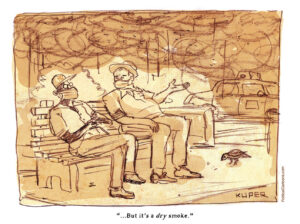Surviving the Cruel Saga of Canada’s Indigenous Boarding Schools
“Sugarcane” tells the story of what kept a people together, despite a systematic effort to alienate them. Julian Brave NoiseCat and his father Ed Archie NoiseCat look down at the Williams Lake Stampede from the top of "Indian Hill" on their roadtrip back to St. Joseph's Mission, where Ed was born. (Emily Kassie/Sugarcane Film LLC)
Julian Brave NoiseCat and his father Ed Archie NoiseCat look down at the Williams Lake Stampede from the top of "Indian Hill" on their roadtrip back to St. Joseph's Mission, where Ed was born. (Emily Kassie/Sugarcane Film LLC)
Named after a reservation in British Columbia, “Sugarcane” is a harrowing and ultimately uplifting look at a very dark chapter of Canadian Indigenous history. It details how, under the guise of providing “education,” generations of Native children were forcibly shipped away from their homes and subjected to unspeakable abuse at residential schools. The wide-ranging 107-minute documentary reveals previously unknown details and tells hard emotional truths about the horrors perpetrated on the children of the continent’s First Nations. A film festival darling, its multiple accolades include the Directing Award at Sundance.
“Sugarcane’s” young co-directors met while working for HuffPost. Julian Brave NoiseCat, a journalist with an activist history, is a member of the Canim Lake Band Tsq’escen and descendant of the Lil’wat Nation of Mount Currie. Emily Kassie is an Emmy and Peabody Award-nominated journalist and filmmaker of Jewish ancestry who grew up in Toronto. I interviewed NoiseCat in Sante Fe and Kassie in Los Angeles via Zoom. Our conversation has been edited lightly for clarity and length.
Truthdig: Please provide an overview of the boarding school abuse at the center of the film.
Julian Brave Noisecat: “Sugarcane” follows an investigation into abuse and missing children at St. Joseph’s Mission, one of 139 federally funded Indian residential schools across Canada. An amendment to the Indian Act in the 19th century made attendance at these Indian residential schools compulsory for all Indigenous children [starting in 1894]. Those schools were designed, in the words of one of the people who oversaw them, to “Get rid of the Indian problem.”
While the story of assimilation, abuse and potential unmarked graves at Indian residential schools has made international headlines in Canada, in the U.S. there was actually an older system of Native American boarding schools that was in some ways the model for Canada. They were set up by an Army captain, Richard Henry Pratt, who described the mission of these schools as, “Kill the Indian and save the man.” [According to the film, 408 were established in the United States.]

They were a continent-wide system of schools that separated Indigenous children from their parents and families. It was enforced by law enforcement and the legal system. If you did not send your children, you could face jail time. There were actually Hopi elders from Arizona who were incarcerated at Alcatraz because they did not want their children to be taken away to these schools.
At these schools there was rampant physical, sexual and psychological abuse. In some instances, even death. That is part-and-parcel to the story of how North America was colonized and what happened to First Peoples here.
Emily Kassie: The last school closed in 1997. These schools ran for over 100 years and took away hundreds of thousands of Indigenous children from their families across North America.
TD: It seems like a sort of “Final Solution to the Indian Question.” The crimes weren’t just carried out by rogue priests; it was more part of institutional racism. Do you contend that these Indian residential schools were part of a coordinated genocidal plot to exterminate Indigenous culture and people, including systemic infanticide?
JBN: Words like “genocide” and “systemic” — it’s really important that we get the terminology correct when we talk about this history. It would be accurate to describe what happened at the Indian residential schools in Canada, as well as Native American boarding schools, as a form of genocide. In fact, the Truth and Reconciliation Commission in Canada officially calls the Indian residential school system “cultural genocide.”
At St. Joseph’s Mission, in our documentary, we uncover a pattern of infanticide where babies who were born to students at the school and in some instances to nuns, were forced into adoptions out of their family and community contexts. In some instances, they were put into the incinerator to be burned with the garbage. Some of those babies were fathered by priests.
People can have a semantic debate how to characterize that. We wanted to prioritize an investigative truth, and on top of that, an emotional truth. What is it for survivors of this history, which still has consequences in the present, to live in the aftermath of that genocide?

TD: Do we know how many children were murdered, or fathered by priests?
EK: What’s so challenging and important about this story is how little we know. How few records have been opened to Indigenous communities and investigators looking for truth. The Catholic Church, Canadian government and police have not fully opened their records to be able to find out what happened. “Sugarcane” uncovers testimony and evidence pointing to these horrific crimes. We’re just at the beginning of understanding the full truth. How can you possibly reconcile without knowing what fully happened? We don’t know how many children passed away at these schools. We now know through the investigation at Sugarcane, there were cases of babies born … who were thrown away.
TD: Tell us about the investigation at St. Joseph’s Mission.
EK: Charlene Belleau and Whitney Spearing are going through any archives and hundreds of interviews of testimony with survivors to try and piece together what crimes occurred at this school. First Nations across Canada are working with ground penetrating radar to detect potential graves and burials in the grounds of these schools.
TD: How about DNA testing?
JBN: They’d like to, but in order to get to that part they’d need to start unearthing potential human remains. There has yet to be a First Nation in Canada that has moved forward with an excavation at a school.
TD: Documentaries are often considered “objective,” but one of you has a very personal connection to this story. Tell us about one of the film’s protagonists, Ed NoiseCat.
JBN: Ed is my dad [laughs]. Firstly, there’s a huge debate about “objectivity” in journalism. I take issue with the notion that there is such a thing as a detached objectivity. Stories require perspective and storytellers — until they replace us with AI. This story is meant to be a very under-the-skin personal story.
That brings up my dad. As one of the directors, “Sugarcane” is as much a journalistic investigation into missing children and abuse at St. Joseph’s Mission as it is a personal investigation into the circumstances around my father’s birth at that Indian residential school. And then the intergenerational impacts of that school on him and our family.

Because my father was — there’s no real easy way to say this — the only known survivor of the incinerator at St. Joseph’s Mission. He was abandoned as a baby and narrowly survived the pattern of infanticide at that school. Then he became a great artist, but carrying his own baggage. He unfortunately did not really raise me or my little sister. So, that cycle of abandonment that began with the Indian residential schools, which systematically kept Native parents from being able to raise their children, had effects on his life, on his parents’ life, and on my life. A big part of “Sugarcane” is about not just the wrongdoing at St. Joseph’s Mission, but also the present injustices that remain long after St. Joseph’s Mission closed.
TD: “Sugarcane” is also a road trip movie and about father-son bonding.
JBN: It is. Yeah, we go on a road trip back to the rez we’re from, at Canim Lake, and the mission where he was born. That’s very true to who we are… and to the greatest hits of Native cinema: “Powwow Highway,” “Smoke Signals,” even FX’s “Reservation Dogs.”
EK: Regarding “objectivity,” we made this film in a particular way, not to be a voiced narration, historical recounting of the residential schools. Instead, we wanted to capture a community’s experience of reckoning in a moment where the truth is coming out and the ghosts have come back to help the story be told. To do that, we decided to film it as a vérité film and follow events as they were happening and get at the perspective and emotional truth of each of our characters.
TD: That’s “Sugarcane’s” power.
JBN: Emily comes from an investigative journalism background, covering atrocity, geopolitical conflict, all around the world. I have a journalistic background as well, but in my own work I often appear as a character, a narrator with a clear perspective and take. You see both practices and approaches to this medium in “Sugarcane.” On the one hand, this film has real investigative merit and teeth — we do break an untold story about a pattern of infanticide at St. Joseph’s Mission. On the other hand, there’s a clear perspective taken following these events through the eyes of our characters, including myself.
TD: Given the horrors “Sugarcane” discloses, is it even possible for humans to overcome this generational trauma? If so, how?
JBN: It’s absolutely possible for people to overcome and also learn how to live with these truths. We can never rewrite what happened. We can of course let people know what happened and grapple with it. But what happened, happened. People suffered and have died as a consequence of that and continue to, to this day.
“Sugarcane” is not just about these atrocities. It’s also about what has held people together and kept them attached to their place, community and culture, despite this massive, continent-scale, systematic effort to alienate people from each other and their selves, with violence. This film also points the camera at things that continue to bring us together, make us love each other and help us endure, like spending time purposefully with one another; listening to each other’s stories; going fishing with your family; going to a powwow with three generations of your loved ones; elders dances put on by First Nations; watching rodeos where you have not just cowboys and Indians, but Indian cowboys.

The fabric of community life brings people together in a world where people are increasingly being driven apart by societal dynamics, by technology, by all these things that are alienating ourselves from our humanity. At the same time, this is a film about people who have been dehumanized, it’s also about people who are in deeper touch with things that are fundamental to who we are as human beings.
TD: What would accountability and justice look like?
EK: We intend to get “Sugarcane” into as many classrooms across North America and correct the record. We are bringing it on a rez tour across North America to get it to Indigenous communities.
JBN: Justice needs to be defined by the people who survived the injustice. The form that justice might take might not be through a court system, a settlement, policy, but might be through ceremony. Indigenous jurisprudence and laws we define as our own sovereign people. Part of the legacy of Indian residential schools is not just what happened to children at these schools — which is truly horrific — but also what that violence and abuse did within the Indigenous communities and families ourselves. How that violence, abuse and addiction became intergenerational.
It’s important if we’re going to move forward as a people, if we’re going to reclaim all of the things that are ours, that we reconcile amongst ourselves. Return to the things that make us who we are, figure out what it means to come together as a people after such a terrible thing was exacted upon us with the intention of tearing us apart.
Sugarcane opened in New York and Toronto Aug. 9 and opens in Los Angeles at the Laemmle Royal and in Chicago, San Francisco, San Diego, Oklahoma City and Tampa on Aug. 16 and expands to additional theaters Aug. 23.
Your support matters…Independent journalism is under threat and overshadowed by heavily funded mainstream media.
You can help level the playing field. Become a member.
Your tax-deductible contribution keeps us digging beneath the headlines to give you thought-provoking, investigative reporting and analysis that unearths what's really happening- without compromise.
Give today to support our courageous, independent journalists.








You need to be a supporter to comment.
There are currently no responses to this article.
Be the first to respond.